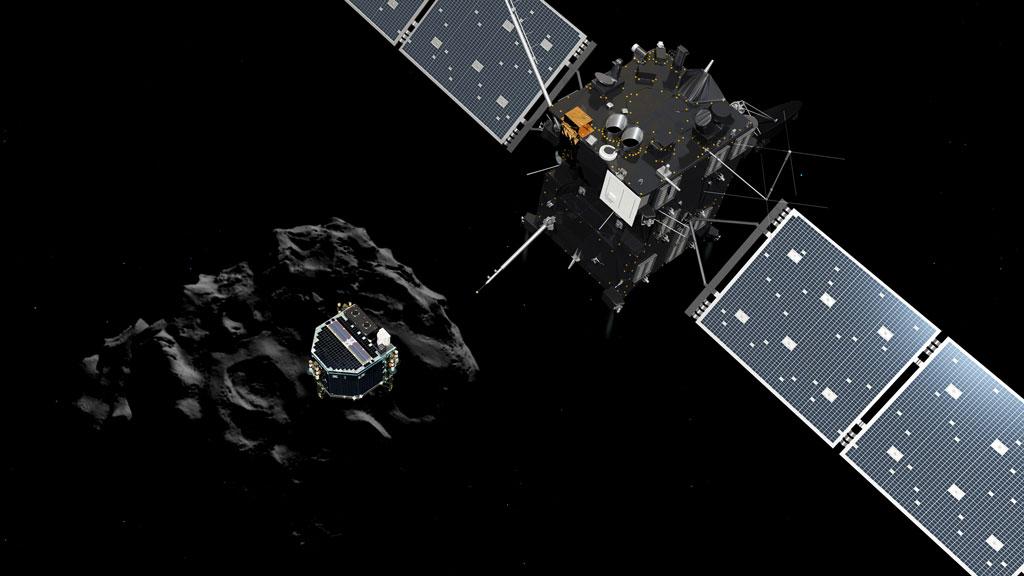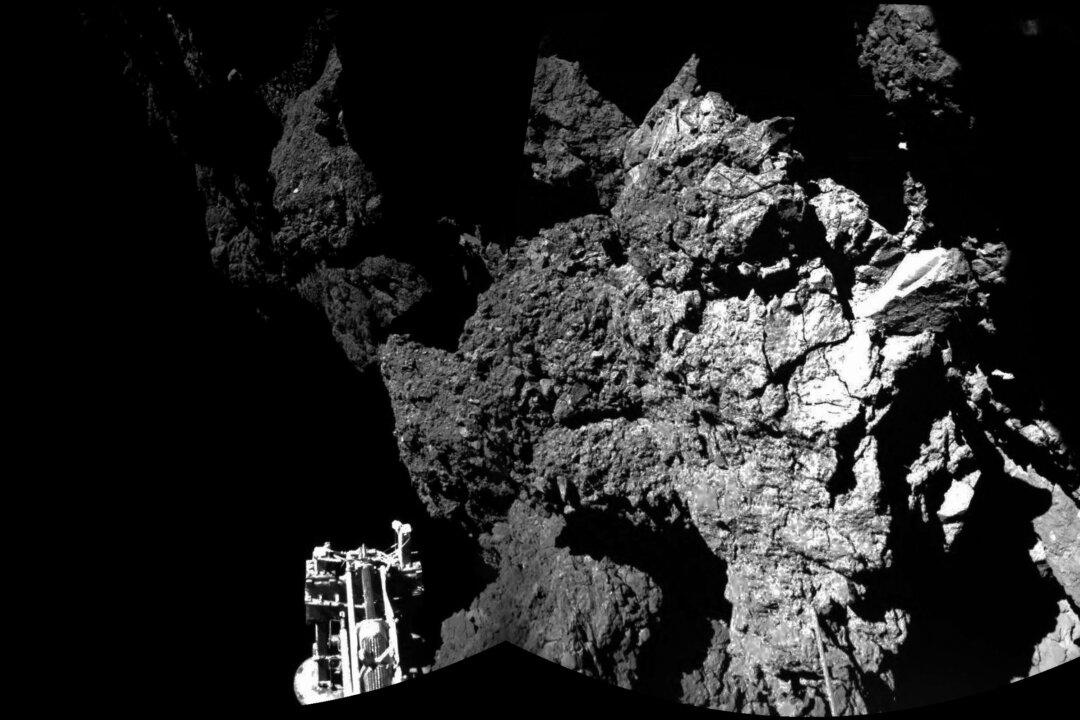DARMSTADT, Germany—Landing with a bounce after traveling 4 billion miles, a European spacecraft made history Wednesday by successfully reaching the icy, dusty surface of a speeding comet — a cosmic first designed to answer big questions about the universe.
The landing by the washing machine-sized craft after a decade-long journey required immense precision, as even the slightest error could have resulted in stellar calamity.
Indications were that the spacecraft touched down almost perfectly, save for an unplanned bounce, said Stephan Ulamec, head of the lander operation.
“Today we didn’t just land once. We maybe even landed twice,” he said with a chuckle.
[aolvideo src=“http://pshared.5min.com/Scripts/PlayerSeed.js?sid=1759&width=480&height=300&playList=518511423&responsive=false”]
Scientists were still trying to fully understand what happened but so far most of the instruments are working fine and sending back data as hoped, he added.
Ulamec said thrusters that were meant to push the lander, called Philae, onto the surface, and harpoons that would have anchored it to the comet failed to deploy properly. Initial data from the spacecraft indicated that it lifted off again, turned and then came to rest.
Scientists were still trying to fully understand what happened and whether those failures would affect the lander’s ability to remain on the comet, called 67P/Churyumov-Gerasimenko. But so far, most of the instruments were working fine and sending back data as hoped, Ulamec said.
“Tomorrow morning we should know a lot more,” he said.
The landing team at mission control in Darmstadt had to sweat through a tense seven-hour wait that began when Philae dropped from the agency’s Rosetta space probe as both it and the comet hurtled through space at 41,000 mph (66,000 kph).
During the lander’s descent, scientists were powerless to do anything but watch, because its vast distance from Earth — more than 300 million miles — made it impossible to send instructions in real time.
Finally, at 16:03 GMT (11:03 a.m. EST), the agency received a signal that the lander had touched down.
While it may take a while to determine the exact state of the 220-pound (100-kilogram) lander, the fact that it was resting on the surface of the comet was already a huge success — the highlight of Rosetta’s decade-long mission to study comets and learn more about the origins of these celestial bodies.
The head of the European Space Agency underlined Europe’s pride in having achieved a unique first ahead of its U.S. counterpart, NASA.
“We are the first to have done that, and that will stay forever,” said the European agency’s director-general, Jean-Jacques Dordain.
NASA contributed three instruments to the mission and its Deep Space Network of giant radio antennas has been key to communicating with Rosetta.
Eight-time spacewalking astronaut John Grunsfeld, now associate administrator for science at NASA, called the landing “a breakthrough moment in the exploration of our solar system and a milestone for international cooperation.”
“The data collected by Rosetta will provide the scientific community, and the world, with a treasure-trove of data,” he said in a statement.
Scientists have likened the trillion or so comets in our solar system to time capsules that are virtually unchanged since the earliest moments of the universe.
“By studying one in enormous detail, we can hope to unlock the puzzle of all of the others,” said Mark McCaughrean, a senior scientific adviser to the mission.
The insight gleaned will give researchers the opportunity to test the theory that comets brought organic matter and water to Earth billions of years ago, giving them a key role in the evolution of life on our planet, said Klim Churyumov, one of the two astronomers who discovered the comet in 1969.
Rosetta and Philae will accompany the 2 ½-mile wide comet as it races past the sun and becomes increasingly active in the rising temperatures. Between them, they will use 21 different instruments to take 3D images, analyze the comet’s chemical composition and electrical properties, and even probe its internal structure with low-frequency radio signals.
Mission manager Paolo Ferri said there was no time to celebrate, because the lander had only enough battery power to operate for up to 64 hours. After that it will have to recharge, using solar panels to eke out an extra hour of operations each day.
Ferri said communications with the lander also needed to be stabilized, as there were intermittent connection problems after the touchdown. In the meantime, all the data that Philae collects is safely being stored for later transmission, he said.
Rosetta, which was launched in 2004, had to slingshot three times around Earth and once around Mars before it could work up enough speed to chase down the comet, which it reached in August. Rosetta and the comet have been traveling in tandem ever since.
5 Questions About the Historic Comet Landing
The European Space Agency has achieved a historic first — landing a washing machine-sized spacecraft on a comet speeding through our solar system at 41,000 mph (66,000 kph). Here are answers to five questions about the space mission:
How Difficult Was It to Land on a Comet?
Nothing like Wednesday’s landing had ever been attempted before.
NASA landed a probe on an asteroid in 2001, but comets are much more volatile destinations because they continually release dust and gas that can harm a spacecraft. Also, because this landing was taking place 311 million miles (500 million kilometers) from the Earth, the Rosetta spacecraft and the Philae lander it carried were both designed to perform the landing autonomously. Once they received the go-ahead, there was nothing scientists at mission control in Darmstadt, Germany could do to adjust the lander’s course.
Philae’s separation from Rosetta also had to be extremely precise. An error of just one inch during separation could have put the lander 250 meters (820 feet) off target on the 4-kilometer (2 ½-mile) wide comet named 67P/Churyumov-Gerasimenko. But Paolo Ferri, head of mission operations for the space agency, said Philae’s landing was almost perfectly on target — save for one unplanned bounce.
Where There Any Problems With the Landing?
Several.
First, the lander failed to wake up properly Tuesday. Scientists fixed that with a trick familiar to anyone who has used a computer. They rebooted it.
After the separation from Rosetta is became clear that there was a problem with Philae’s downward thrusters. They were designed to press the lander onto the surface during the final touchdown, to help it get a grip using harpoons and screws. The thruster failure wouldn’t have been so dramatic if the harpoons had fired, but they didn’t. So Philae bounced, once, before coming to rest again on the comet.
Scientists are also trying to resolve intermittent communication problems with the lander, but those shouldn’t interfere too badly with the mission.
What Data Are Scientists Seeking?
Scientists have likened the trillion or so comets in our solar system to time capsules that remain virtually unchanged since the earliest moments of the universe. One of the things they are most excited about is the possibility that the mission might help confirm that comets brought the building blocks of life — organic matter and water — to Earth. They already know that comets contain amino acids, a key component of cells. Finding the right kind of amino acids and water would be an important hint that life on Earth did come from space.
How Will the Lander Collect Data?
“The science starts the minute we get down to the ground,” said Mark McCaughrean, a senior scientific adviser on the mission. Philae has ten instruments on board — including devices to measure light, electrical magnetism and heat — and flying up above the comet the Rosetta spacecraft has another 11 instruments. The Philae lander will provide plenty of images of a world no human has ever seen close up and will drill below the surface to extract a sample of the comet that will be analyzed onboard.
The lander’s batteries are expected to last just 64 hours — but that should be enough for scientists to gather a huge wealth of data. In addition, the lander has a solar panel that should provide an hour’s worth of battery life per day for up to five months.
What Challenges Lie Ahead?
The comet is on a 6 ½-year elliptical orbit around the sun. At the moment it is getting closer to our star. This makes for great science, since Philae and Rosetta will be able to observe the comet becoming more active.
As 67P approaches the sun, the amount of matter it sheds will greatly increase, posing a potential risk to the lander and even to the Rosetta spacecraft flying in tandem with the comet. As the comet reaches perihelion, the closest point to the sun, the rising temperatures could also damage Philae. But the lander should remain stuck to the comet forever, even after its systems have shut down. Rosetta will continue to fly alongside the comet until the end of its useful lifetime in about two years. Scientists have suggested that a fitting end would be for it, too, to land on the comet and reunite with the lander once more.
From The Associated Press

